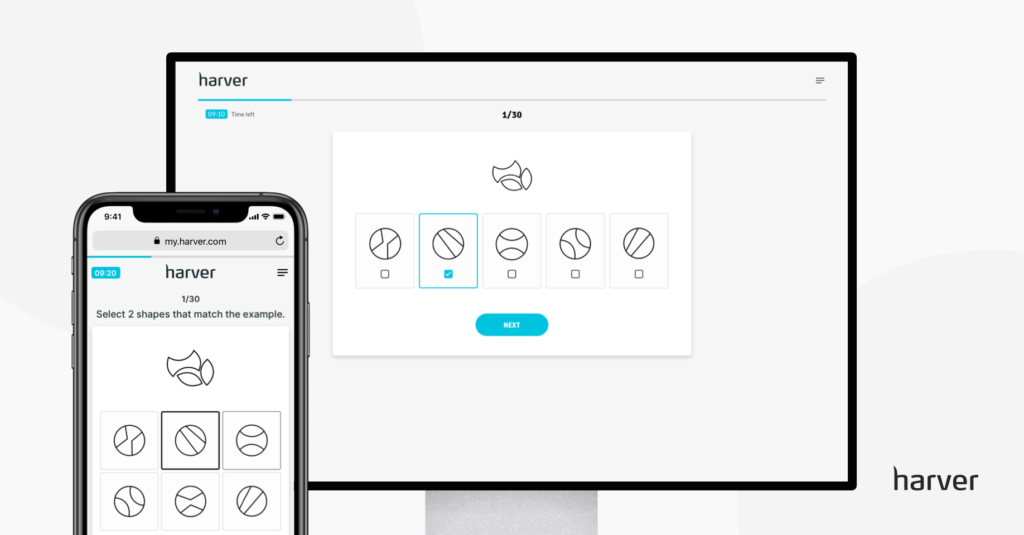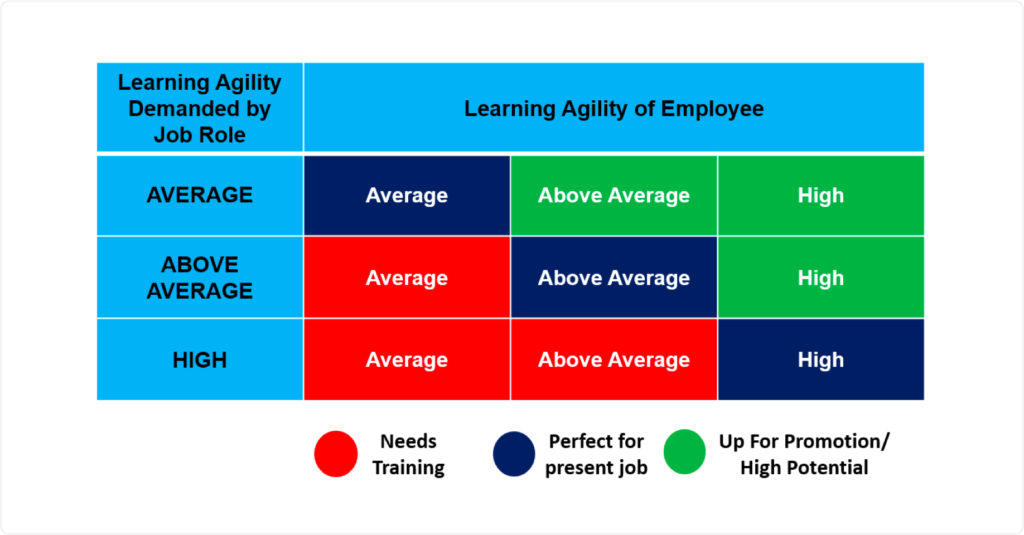This post was originally published in September 2020 and was last reviewed and updated on September 18, 2025.
Learning agility has become an increasingly popular concept in the last decade. In particular, interest in learning agility skills has spiked as employers add more emphasis on how to enable internal mobility. HR professionals have been determining learning agility in the workplace to identify and further develop high-potential talent as well as for selecting organizational leaders globally.
Warner Burke, Professor of Psychology and Education at Teachers College, Columbia University, says that of all the leaders hired, 50% of those fail at what they were hired to do. Why? Because they lack learning agility.
But what exactly is learning agility in leadership and in the workplace? Is it a skill? Why is it crucial for organizations? And what can you do from a recruitment standpoint to hire for it? More specifically, how do you assess applicants on their learning agility skills?
Let’s dive in!
What is learning agility in leadership?
Before we delve into the importance of learning agility in leadership and how you can determine this competency among job seekers, let’s look at what the term actually means.
Is learning agility a skill?
In a nutshell, learning agility is a set of complex skills that enable us to learn something new in one place and then apply what we learned elsewhere, in a wholly different situation.
Learning agility is our ability to:
- learn, unlearn, and relearn quickly,
- apply newly learned information and skills to innovate and adapt as workplace conditions change, and
- use feedback to improve.
What does learning agility mean in the workplace?
Learning agility dictates how we can figure out a way through a new situation without actually knowing what to do, by using past and present experiences to make sense of an uncertain situation.
It’s also being open to new ideas and innovating rather than relying on outdated information. When you’re an agile learner, you’re comfortable being uncomfortable. Agile learners seek out new challenges, ask for feedback from others to learn and grow, and are reflective.
An agile learner has the mindset that allows them to continually develop their understanding, to grow, and use new strategies that they’ve learned along the way, in order to ready themselves to successfully navigate any future problems.
Having learning agility skills in your workforce is good. Executives with learning agility in leadership positions? Even better.

Executives with high levels of learning agility, tolerance for ambiguity, empathy and social fluidity are
5x
more likely to be highly engaged.
Source: Korn Ferry
Are some people more learning agile than others?
Learning agility can be taught and learned at any stage in life. And like a muscle, if you want this skill to grow stronger, you need to constantly work at it.
Being able to call yourself an agile learner isn’t about what you have accomplished previously; it’s about the potential you have to accomplish future tasks.

Learning agility is correlated with some of the “Big Five” personality traits, such as agreeableness, openness to experience, and conscientiousness.
On the other hand, a person who’s emotionally unstable is less likely to be learning agile. Likewise, those who believe that events in their life are caused by uncontrollable external factors are also less likely to be learning agile.
Therefore, assessing a candidate’s personality alongside measuring their learning agility is beneficial and completes the picture of someone’s profile and characteristics.
Why is learning agility an essential skill at work?
If organizations want to succeed, they need to have leaders who possess learning agility because it’s a reliable indicator of a person’s leadership potential. As we mentioned above – 50% of hired leaders will fail at their job because they lack this precise skill.
Successful leaders manage disruption; they roll with the punches and adapt their strategies accordingly, in order to deliver success for the company. In short, exceptional leaders are adaptable, resilient, and open to thinking innovatively.
According to the Korn Ferry Institute, learning agility should be considered the single best predictor of an executive leader’s success, ranking it above intelligence and education.

Companies with the greatest rates of highly learning agile executives produced
25%
higher profit margins compared with peer companies.
Source: Korn Ferry
With learning agility in your leadership and workforce, you’re capable of unlearning old beliefs and practices that are no longer relevant in today’s business. This allows your organization to seek out and learn from new experiences.
To list just a few learning agility examples in the workplace, agile learners tend to:
- Make high-quality decisions on the spot, with confidence. Connect the dots even without compelling or complete data to work from.
- Develop innovative solutions based on their ability to unlearn old solutions that no longer work.
- See the bigger picture – look beyond what they already know and integrate unrelated pieces of information to gain a better perspective.
- Be adaptable in their approach to a complex issue. Be open to sudden or unexpected change and be flexible – this comes from their drive to succeed.
- Deal with unfamiliarity and uncertainty confidently, rather than shy away from new and strange situations.
- Possessing the ability of agile learning means leaders are continually adapting to new business strategies, embracing working across cultures, taking remote working and dealing with temporary virtual teams in their stride, taking on new tasks but remaining unfazed when handed unfamiliar assignments.
- Fill leadership roles effectively and rocket up the ranks. While there are no definite numbers, Korn Ferry research shows that people with high learning agility are more likely to be promoted
- Innovate. People who don’t possess learning agility tend to over-rely on past solutions to deal with current problems rather than look for new solutions.

Highly learning agile individuals are
18x
more likely to be identified as high-potential employees than their colleagues with lower LA scores.
Source: Korn Ferry
Best practices for determining learning agility
When you’re hiring employees for positions where learning agility is predictive for success, such as leadership roles or management trainees, it’s important that you assess it in your recruitment process.
How exactly can you do this?
1. Use a scientifically-validated learning agility assessment
A dedicated learning agility assessment is the best tool you can have at your disposal to assess candidates for agile learning. When you carry out the assessment, make sure that all candidates are aware of what they’re being tested on and why you’re testing them.
The Harver platform offers Personality Print, a scientifically validated personality assessment that can measure learning agility. This solution offers a detailed candidate profile to help recruiting teams make informed decisions when selecting candidates for roles where LA is important.
Our Personality Print tool assesses learning agility as a competency comprised of 7 traits, as proprietarily determined by our People Scientists. It also provides guidelines on how to interpret these scores.
Although learning agility assessments can be used individually, we usually recommend combining them with other assessments, such as cognitive ability or personality questionnaires.
If you’d like to see these in action and learn what solution would be the best for your specific case, you can book a demo below.
2. Consider the relationship between cognitive ability and learning agility
Cognitive or learning ability is an important aspect in relation to learning agility. Smarter does not necessarily mean more learning agile, but an individual needs to have a certain level of cognitive ability to be able to be learning agile.
Therefore, the combination of a personality assessment that can measure learning agility and a cognitive ability test makes a powerful couple when assessing candidates. Harver’s cognitive ability test, for example, assesses the core components of Fluid Intelligence: Logical reasoning, Verbal reasoning, Numerical reasoning, and Spatial Ability.

You can learn more about these two assessments below.
3. Focus on the candidate’s ability to adapt during the interview
In your structured interview process, ask open-ended questions such as:
- ‘Tell me about a time when you asked for feedback from your boss or a colleague. Who did you solicit the feedback from? What was the feedback you were given? Why did you want the feedback?’
- ‘Tell me about a time when you made a mistake at work. What was the mistake you made, and what did you learn? Who did you tell about your mistake? How did they react to the news?’
- ‘Tell me about a time when you had to do something you’d never done before. How did you feel about it? What did you learn doing it?’
- To test a candidate’s ability to roll with the punches and adapt to a novel situation, ask them ‘what if’ style questions to try to resolve. For example: ‘What if you were given a new task to complete, what steps would you take to get started on it?’
- When the candidate confidently answers the ‘what if’ question, throw in a curveball and test their speed and flexibility to solve problems. Remove a resource, reduce their budget or time, and ask them how they would reach the same outcome in these different circumstances.
You’re looking for responses that demonstrate the key behaviors of learning agility as identified by Burke, which include: feedback-seeking, interpersonal risk-taking, collaboration, experimentation, and reflection, as well as speed and flexibility.

Mettl Learning Agility Matrix explains how learning agility demanded by a role and learning agility of an employee relate to each other.
4. Provide training to current employees
If you want to determine where gaps are in learning agility among your existing employees, provide them with training on learning agility. Doing this will enable employees to recognize the exact behaviors that people with those exact skills demonstrate.
Once employees understand what it means to be an agile learner, they can identify which dimension they are lacking, or where they have been underperforming in order to improve.
Next steps for learning agility skills in your workplace
Learning agility is an extremely important competency for leaders. So if you’re looking to develop future leaders and changemakers, make sure you assess your candidates for this skill in your recruitment process.
If you’d like to see what the Personality Print Professional module for assessing learning agility looks like in the Harver platform, and how you can incorporate it into your candidate selection process, book a demo now.


